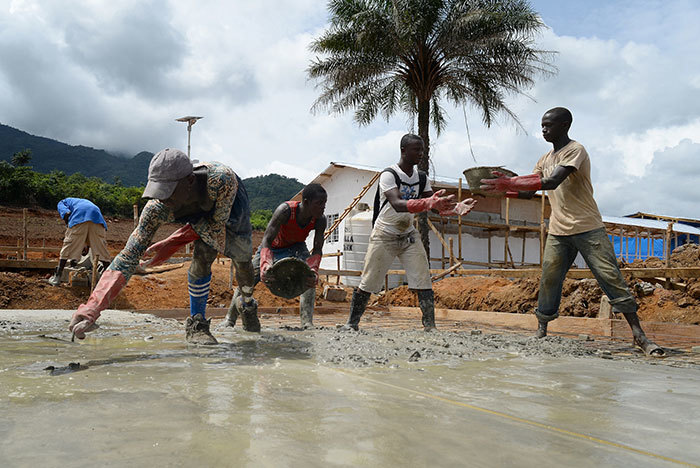Ebola: journey to a quarantined village
28 October 2014 | Story by Newsroom
In her latest article from the frontline of the Ebola epidemic, Kathryn Stinson looks for answers in a quarantined village in Sierra Leone.
We're on the road again. This time, to investigate a new hotspot. A woman and her three-year-old child came in yesterday in one of the ambulances, both with signs and symptoms, both from a remote village that had just appeared on my epidemiological radar.
They were undoubtedly linked to the man in my previous article, who died last week, and these two had most probably been among the group who went to another town to witness his wife's funeral. I was about to interview the mother after admission, to try to find out more about her and her daughter.
As we stood in our usual spot between low- and high-risk, with the two-metre boundary fences between, the health promoter called out her name. From behind, another health promoter appeared and reported, "Case X has just died." I looked down at my clipboard, and was at a loss for words. "Don't call her," I urged my colleague. "She's just lost her daughter."
There was some movement in the confirmed-cases tent, with the medical and sanitation staff in hazmat suits walking in and out. The mother was led out gently, supported by another hazmat suit, off to another tent, presumably to save her from witnessing what was to happen next. She walked hesitantly and looked dazed and weak, wearing nothing but a t-shirt and a nappy. It was a scene I will never forget '“ a tragic depiction, at a specific point in time, of loss of life, control and dignity.
"She was so beautiful," the medic said to me afterwards, during dinner. He had assisted with the swabbing of the dead child for laboratory testing, before she had been prepared for the morgue.
As an epidemiologist, it is my task to draw the links between the cases, to investigate what may have given rise to the infection, and to assist in prevention by informing the health promotion team where to go next. The health promotion officer and I work closely with a vibrant team of local staff who are streetwise, passionate about fighting Ebola, and above all else, brave. Five of us headed off north-west for a journey in search of answers. For me, it felt more personal. Having been (though somewhat vicariously) involved at the moment of death and loss, I needed to see where the mother and her daughter had lived. Somehow, I needed to fix things.
We had heard of this village: that there were challenges. The whole village had been quarantined. Cell phone coverage was very limited, making it difficult to dial the national toll-free Ebola alert line. Furthermore, there was speculation that the community was in denial about Ebola; that they were hiding cases, and secretly burying their dead. Given its remoteness, there were known challenges to implementing surveillance and contact tracing.
After a four-hour journey on unbelievably poor roads, which have been eroded even further due to the heavy rains over the past months, we arrived in what I can only describe as a movie set.
The main road through the village was empty, and to the left and right, people sat on their verandas, and children played at a distance. The verges of the streets were populated by a handful of dogs and chickens, who couldn't be held to quarantine rules. We were met by members of the police and the army, who then arranged for us to meet with the chief, who was quarantined himself, as a suspect.
As we were disembarking, our car was cornered by an ambulance and a hearse. The drivers told us they were heading to the neighbouring town to collect more suspects '“ including healthcare workers who were showing signs and symptoms.
We spoke to key community members about the events of the past few days. What unravelled was a depressing tale of normal community life gone horribly wrong, just because of Ebola.
The town has no water services '“ everyone uses the stream '“ and no-one has a toilet. There are food shortages. Another woman had taken ill, and had been transported by ambulance that day to our treatment centre, leaving a six-month-old child alone. We asked to see the child, and inquired as to whether she was being monitored.
I wrote notes in the blazing sun, taking down names and plotting links while not being able to wipe the sweat dripping off my face, given the 'no touch' protocol.
After demonstrating the use of a thermometer, we left the baby, with strict instructions to a caregiver not to share the thermometer, and we distributed bars of soap and flyers about Ebola to all the houses, throwing these from the main road onto the verges, while a health promoter relayed Ebola information over a megaphone. People seemed so happy to see us, even if from a distance.
The four-hour journey back to Kailahun was punctuated by the songs of Lucky Dube, Ziggy Marley and Akon, supplied by one of the health promoters and interrupted occasionally by the crackle of the two-way radio '“ to check where we were. After we disembarked, we dutifully sprayed our feet and washed our hands, and the health promoters and I parted with the usual words: "See you tomorrow, and for God's sake, stay safe." An interesting way indeed to spend my birthday.
 Kathryn Stinson has a PhD in Public Health and is an epidemiologist at the University of Cape Town. She has three children, two Great Danes and one very supportive husband. Kathryn writes in her personal capacity.
Kathryn Stinson has a PhD in Public Health and is an epidemiologist at the University of Cape Town. She has three children, two Great Danes and one very supportive husband. Kathryn writes in her personal capacity.
Photo of Kathryn Stinson and article were first published on GroundUp under a Creative Commons 4.0 License. Photo of construction site provided courtesy of UK Department for International Development under creative commons 2.0 license.
Read more:
Ebola: what we need to do
 This work is licensed under a Creative Commons Attribution-NoDerivatives 4.0 International License.
This work is licensed under a Creative Commons Attribution-NoDerivatives 4.0 International License.
Please view the republishing articles page for more information.










